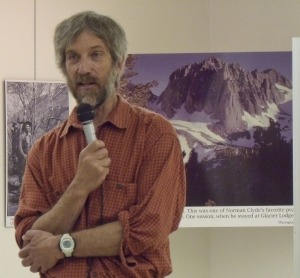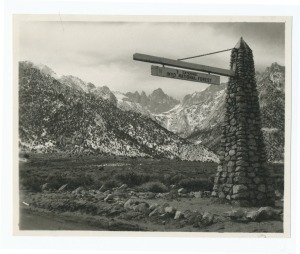Local author signs copies of latest book, “Inyo National Forest”

Andy Selters speaking during the opening of the Norman Clyde exhibit at the Eastern California Museum. Photo courtesy Eastern California Museum.
Local author Andy Selters will be signing copies of his most recent book, “Inyo National Forest,” from 4-6 p.m. on Saturday, April 21, at the Eastern California Museum, 155 N. Grant St., in Independence.
The book is a sweeping and comprehensive view of the pristine lands that serve as the high-country backyard for Inyo and Mono counties. The text is complimented by more than 200 historic photos that show how the forest has evolved over the past century, from a resource-driven enterprise to one of the nation’s premiere recreational, wild land and Wilderness forests. The photos came from the Inyo National Forest Archive, the Eastern California Museum, the Laws Museum, private collections and Selters’ own photos.
Selters’ brings a solid set of qualifications to the task of bringing all the elements of this complex story together. The Bishop resident has spent the last 20 years exploring the Inyo National Forest as a hiker, technical climber and boulderer, skier, photographer and cartographer. As a writer and photographer, he has documented the Eastern Sierra and other mountain experiences in books such as the highly acclaimed “Ways to the Sky, A Historical Guide to N. American Mountaineering,” “The Mt. Shasta Book,” and “Glacier Travel and Crevasse Rescue.” Selters also was the guest curator for the Eastern California Museum’s Norman Clyde exhibit.
“Inyo National Forest” was completed by Selters in collaboration with the Eastern Sierra Interpretive Association (ESIA). The non-profit group was formed in 1971 and is best known as the operator of high-quality book stores and visitors centers in Lone Pine, Bishop, Mammoth Lakes and Mono Lake. The organization works in partnership with the Forest Service and the Bureau of Land Management to provide information about the Eastern Sierra’s public lands and assists it partners with educational, historical, scientific and interpretive activities and programs.

A rather artistic Inyo National Forest sign with Mt. Whitney in the background. Photo courtesy Eastern California Museum.
The Inyo National Forest is comprised of the great eastern front of the Sierra Nevada and the nearly as high White and Inyo mountains, just across the floor of the Owens Valley. Established by President Teddy Roosevelt at the turn of the 20th century as part of the larger plan to provide the valley’s water to Los Angeles, the forest now spans 165 miles and two million acres. It has become of the most popular, and most-visited national forests in the U.S. It is “bookended” on the north by Yosemite National Park and on the south by Sequoia Kings Canyon National Park.
Selters tracks the progress of the forest, and the men (mostly) who were assigned the task of managing the ever-expanding stretch of spectacular public land through its early years. Early forest management focused on resource extraction, be it timber or minerals. Livestock grazing, both for sheep and cattle, was also a primary use of forest lands, as it still is today. Hunting and fishing were, and remain, prime attractions. Also in its earliest years, the Inyo’s towering peaks and untrammeled open country attracted adventurers seeking to climb its mountains and enjoy its solitude, ranging from naturalist John Muir to pioneering climber Norman Clyde.
After WW II, modern forest management came to the Inyo, as did more intense recreational uses such as ski resorts, which sprouted from Onion Valley to Mammoth, and a few spots in between.
In the book, Selters approaches the many ways people have used and enjoyed the Inyo. Chapters in the book address the Backcountry, Skiing, Recreation, and Climbing, and take the reader from the beginning of those popular pursuits to the present day. A chapter is also devoted to Science and Conservation.
Plus, Selters delves into the artistic side of the back country, and reveals how the Inyo National Forest has inspired writers, such as Mary Austin, painters, from Robert Clunie to Jill Kinmonth Boothe, and photographers, from Ansel Adams to Galen Rowell, and any number of filmmakers.
The photos are an outstanding mixture of scenic shots, historic photos of forest construction and mining and farming, pictures of the men and women who managed and studied the forest, and the many kinds and types of people who have enjoyed the Inyo National Forest for more than a century.
Copies of the book will be available for purchase during the event.
For more information, call 760-878-0258.

















